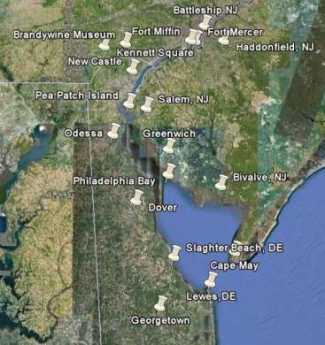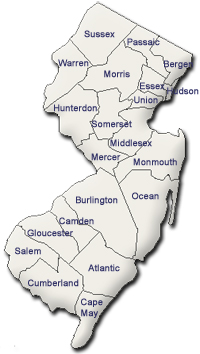Related Topics
Historical Preservation
The 20% federal tax credit for historic preservation is said to have been the special pet of Senator Lugar of Indiana. Much of the recent transformation of Philadelphia's downtown is attributed to this incentive.
Particular Sights to See:Center City
Taxi drivers tell tourists that Center City is a "shining city on a hill". During the Industrial Era, the city almost urbanized out to the county line, and then retreated. Right now, the urban center is surrounded by a semi-deserted ring of former factories.
City of Rivers and Rivulets
Philadelphia has always been defined by the waters that surround it.
Land Tour Around Delaware Bay
 Start in Philadelphia, take two days to tour around Delaware Bay. Down the New Jersey side to Cape May, ferry over to Lewes, tour up to Dover and New Castle, visit Winterthur, Longwood Gardens, Brandywine Battlefield and art museum, then back to Philadelphia. Try it!
Start in Philadelphia, take two days to tour around Delaware Bay. Down the New Jersey side to Cape May, ferry over to Lewes, tour up to Dover and New Castle, visit Winterthur, Longwood Gardens, Brandywine Battlefield and art museum, then back to Philadelphia. Try it!
Favorite Reflections
 In no particular order, here are the author's own favorites.
In no particular order, here are the author's own favorites.
New Jersey (State of)
 The Garden State really has two different states of mind. The motto is Liberty and Prosperity.
The Garden State really has two different states of mind. The motto is Liberty and Prosperity.
Battleship New Jersey: Home is the Sailor

|
Home is the sailor, wrote A. E. Housman, Home from the sea. In this case, the sailor is the Battleship New Jersey. The U.S.S. New Jersey rides at permanent anchor in the Delaware River, tied to the Camden side. You can visit the ship almost any afternoon, and with reservations can even throw a nice cocktail party on the fantail. It's an entertaining thing to do under almost any circumstances, but the trip is more enjoyable if you spend a little time learning about the ship's history. The volunteer guides, many of them still grizzled veterans of the ship's voyages, will be happy to fill in the details.
In the first place, the ship's final bloody battle was whether to moor the ship in the Philadelphia harbor, or New York harbor, when the U.S. Navy had got through using it. You can accomplish that and remain in the state of New Jersey either way, but there's a big social difference between North Jersey and South Jersey, so the negotiations did get a little ugly. Because of the way politics go in Jersey, it wouldn't be surprising if a few bridges and dams had to be built north of Trenton to reconcile the grievance, or possibly a couple of dozen patronage jobs with big salaries but no work requirement. The struggle surely isn't over. Battleships are expensive to maintain, even at parade rest; if you don't paint them, they rust. Current revenues from tourists and souvenirs do not cover the costs, so the matter keeps coming up in corridors of the capitol in Trenton.

Home is the sailor, home from sea:
Home is the hunter from the hill:
'Tis evening on the moorland free, 
|
|
A. E. Housman
R.L.S. |
Battleship design gradually specialized into a transport vehicle for big cannon, ones that can shoot accurately for twenty miles while the platform bounces around on the ocean surface. Situated in turrets in the center of the vessel, they can shoot to both sides. That's also true of armored tanks in the cavalry, of course, with the history in the tank's case of the big guns migrating from the artillery to the cavalry, causing no end of a jurisdictional squabble between officers trained to be aggressive for their teams. Originally, the sort of battleship which John Paul Jones sailed was expected to attack and capture other vessels, shoot rifles down from the rigging, send boarders into the enemy ships with cutlasses in their teeth, and perform numerous other tasks. In time, the battleship got bigger and bigger so in order to blow up other battleships had to sacrifice everything else to sailing speed and size of cannon. Protection of the vessel was important, of course, but in the long run, if something had to be sacrificed for speed and gunpowder, it was self-protection. There's a strange principle at work, here. The longer the ship, the faster it can go. Almost all ocean speed records have been held by the gigantic ocean liners for that reason. If you apply the same idea to a battleship, the heavy armored protection gets necessarily bigger, and heavier as the ship gets longer, and ultimately slows the ship down. As a matter of fact, bigger and bigger engines also make the ship faster, until their weight begins to slow them down. Bigger engines require more fuel and carrying too much of that slows you down, too. Out of all this comes a need for a world empire, to provide fueling stations. Since the Germans didn't have an empire, they had to sacrifice armor for more fuel space and more speed, to compensate for which they had to build bigger guns but fewer of them. Although the British had more ships sunk, they won the battle of Jutland because more German ships were incapacitated. When you are a sailor on one of these ships, it's easy to see how you get interested in design issues which may affect your own future. An underlying principle was that you had to be faster than anything more powerful, and more powerful than anything faster.
The point here is that the New Jersey, as a member of the Iowa class of battleship, was arguably the absolutely best battleship in world history. At 33 knots, it wasn't quite the fastest, its guns weren't quite the biggest, its armor wasn't quite the thickest, but by multiplying the weight of the ship by the length of its guns and dividing by something else you get an index number for the biggest worst ship ever. The Yamamoto and the Bismarck were perhaps a little bigger, but the New Jersey was at least the fastest meanest un-sunk battleship. Air power and nuclear submarines put the battleship out of business so the New Jersey will hold the world battleship title for all time. Strange, when you see it from the Ben Franklin Bridge, it looks comparatively small, even though it could blow up Valley Forge without moving from anchor.
One story is told by Chuck Okamoto, a member of the Green Berets who was sent with a group of eight comrades into a Vietnamese army compound to "extract" an enemy officer for interrogation. When enemy flares lit up the area, it was clear they were facing thousands of agitated enemy soldiers, and Okamoto called for air support. He was told it would take thirty minutes; he replied he only had three minutes, and to his relief was told something could be arranged. Almost immediately the whole area just blew up, turned into a desert in sixty seconds. The guns of the New Jersey, twenty miles away, had picked off the target. The story got more than average attention because Okamoto's father was Lyndon Johnson's personal photographer, and Lyndon called up to congratulate.
A number of similar stories led to the idea that naval gunfire might have destroyed some bridges in Vietnam which cost the Air Force many lost planes vainly trying to bomb, but, as the stories go, the Air Force just wouldn't permit a naval infringement of its turf. This sort of second-guessing is sometimes put down to inter-service rivalry, but it seems more likely to be just another technology story of air power gradually supplanting naval artillery. Plenty of battleships were sunk by bombs and torpedo planes before the battleship just went away. If you sail the biggest, worst battleship in world history, naturally you regret its passing.
Tourists will forever be intrigued by the "all or nothing" construction of the New Jersey. Not only are the big guns surrounded by steel armor three feet thick, but the whole turret for five stories down into the hold is also similarly encased in a steel fortress. This design traces back to the battle of Jutland, where a number of battlecruisers were blown up because the ammunition was stored in areas of the hold not nearly so protected as the gun itself. Putting it all within a steel cocoon lessened that risk, and had the side benefit that when ammunition accidentally exploded, the damage was confined within the cocoon. It must have been pretty noisy inside the turret when it was hit, sort of like being inside the Liberty Bell when it clangs. But not so; stories have been told of turrets hit by 500-pound bombs which the occupants didn't even notice. The term "all or nothing" refers to the fact that the gun turrets are sort of passengers inside relatively unprotected steering and transportation balloon. In order to save weight, most of the armor protection is for the gun. That's a 16/50, by the way. Sixteen inches in diameter, and fifty times as long. With the weight distributed in this odd manner, the Iowa class of dreadnought was more likely to capsize than to sink. Accordingly, the interior of the hull is broken up into watertight compartments, serviced by an elaborate pumping system. Water could be pumped around to re-balance a flooded hull perforation, certainly a tricky problem under battle conditions.
Originally published: Friday, June 23, 2006; most-recently modified: Monday, May 20, 2019
| Posted by: Alex Rodmell | Aug 6, 2009 12:54 AM |
The second is a smaller problem. But, one that impacts revenue. That is their pitiful gift shop. There are guests there ready to spend money. The paltry selection prevents that. The selection on ebay is much better than those onsight.
Get a clue. Spend a little money to make some. In regards to the gift shop, it will come back with a profit margin.
| Posted by: Alex Rodmell | Aug 2, 2009 12:29 AM |